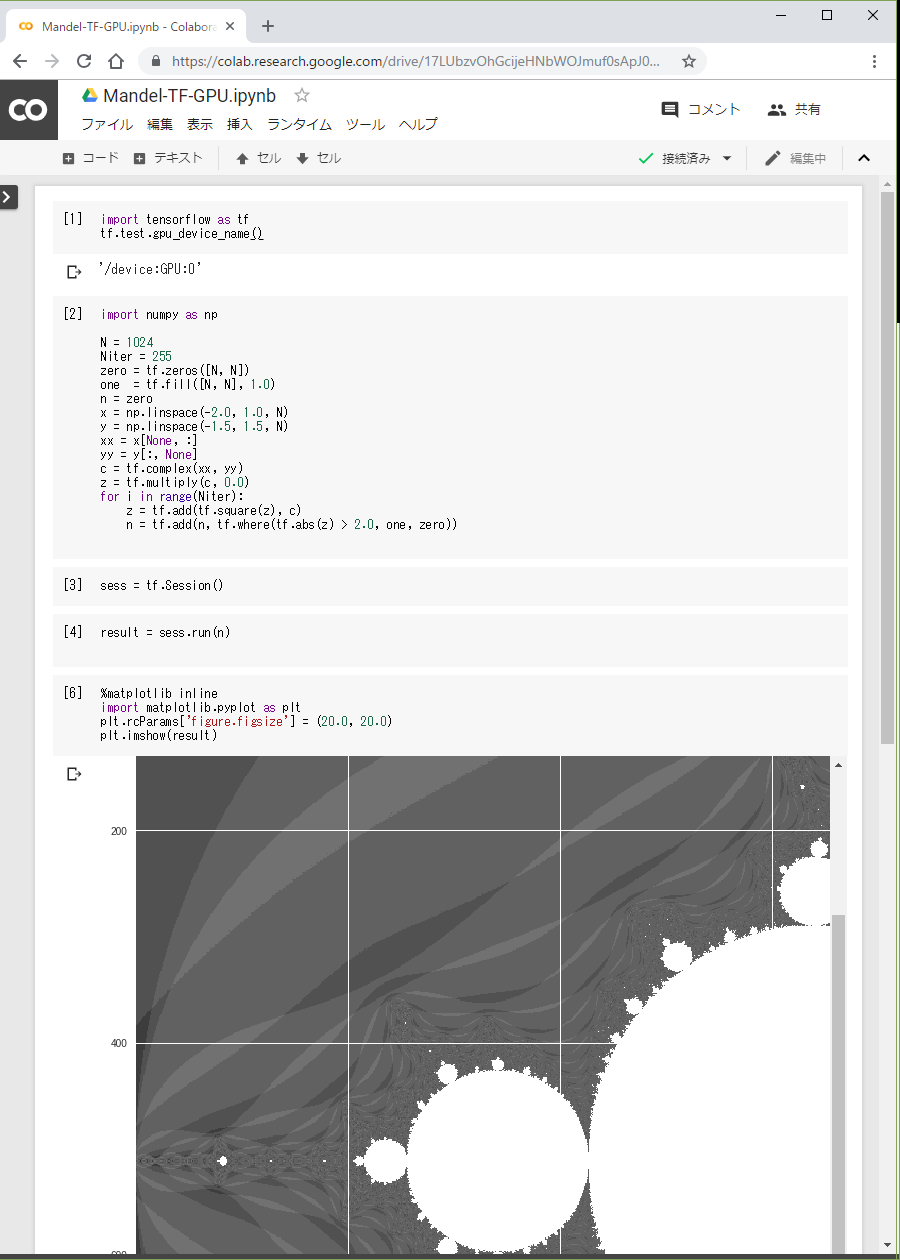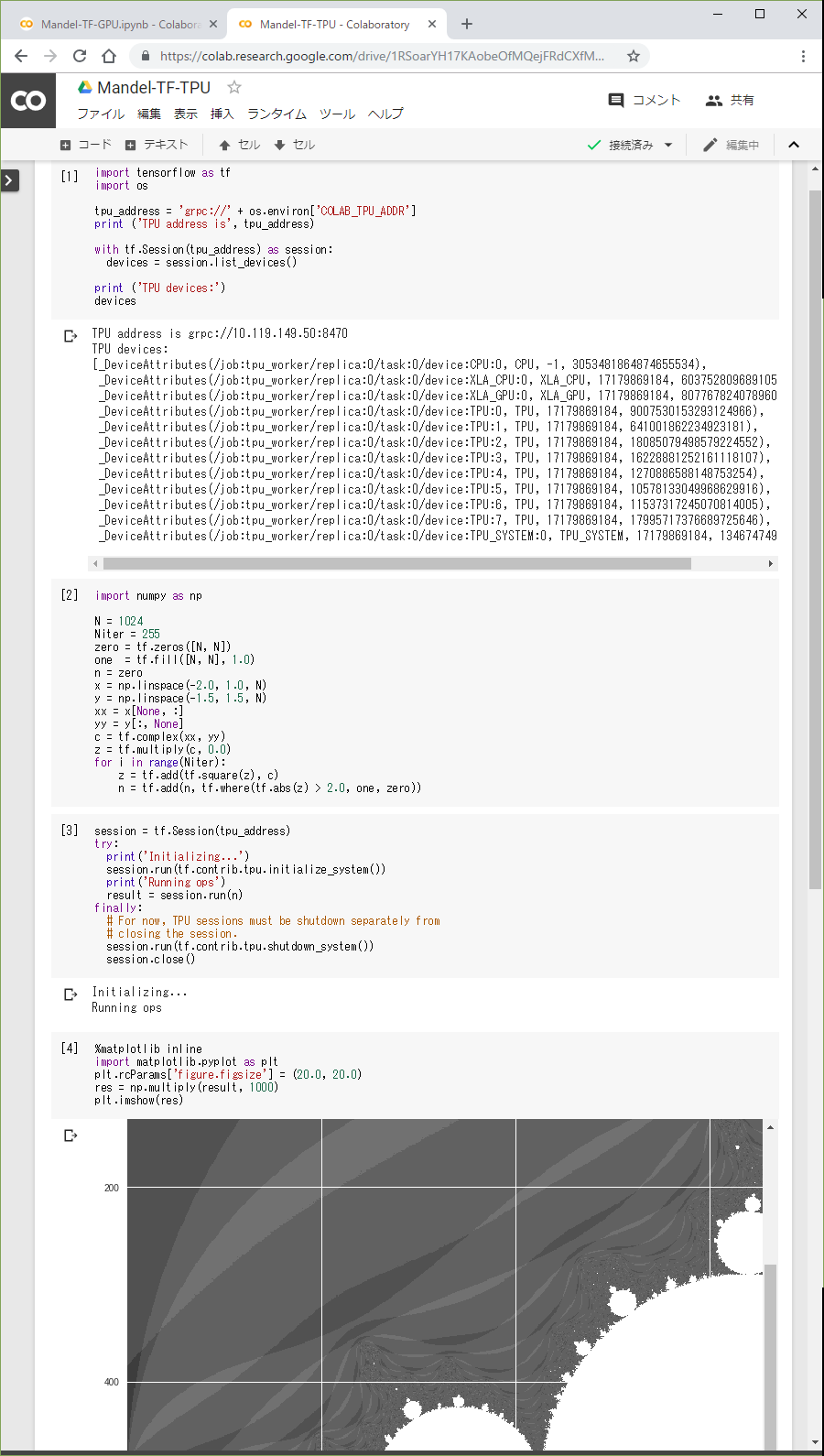TensorFlow?
Google Colaboratory で TPU が使えるということで盛り上がっているようなので、訳の分からぬまま使ってみることにしてみました。Qiita 等各種記事を見る限り、TensorFlow というライブラリから呼び出すようになっているようです。
TensorFlow というものを調べてみると、どうも配列演算のサブルーチン集のようで、Fortran でいえば、’70年代や’80年代のアレイプロセッサ時代に逆戻りしたような趣きです。ただリダクション演算が拡張されていて、指定の任意の Rank 間でリダクション演算ができるようになっています。これは、Fortran で不満に思う所なので中々気が利くなと思いました。Tensor の名前の由来と思われます。
けしからんことに、各種言語用の API が用意されているのに、最もふさわしいと思われる Fortran 用がありません。**死刑!**ここでは、Python で利用してみます。
計算時間を比較すると、計算の性質かあるいは使い方を間違っているのか、GPU の方が TPU よりかなり速い感じでした。Mandelbrot 図形もなにか荒いので、計算間違ってるかもしれません。Python も初心者なので許してね。
Google 謹製例題
TensorFlow マニュアル
プログラム
GPU
import tensorflow as tf
tf.test.gpu_device_name()
import numpy as np
N = 1024
Niter = 255
zero = tf.zeros([N, N])
one = tf.fill([N, N], 1.0)
n = zero
x = np.linspace(-2.0, 1.0, N)
y = np.linspace(-1.5, 1.5, N)
xx = x[None, :]
yy = y[:, None]
c = tf.complex(xx, yy)
z = tf.multiply(c, 0.0)
for i in range(Niter):
z = tf.add(tf.square(z), c)
n = tf.add(n, tf.where(tf.abs(z) > 2.0, one, zero))
sess = tf.Session()
result = sess.run(n)
%matplotlib inline
import matplotlib.pyplot as plt
plt.rcParams['figure.figsize'] = (20.0, 20.0)
plt.imshow(result)
実行例 GPU
TPU
import tensorflow as tf
import os
tpu_address = 'grpc://' + os.environ['COLAB_TPU_ADDR']
print ('TPU address is', tpu_address)
with tf.Session(tpu_address) as session:
devices = session.list_devices()
print ('TPU devices:')
devices
import numpy as np
N = 1024
Niter = 255
zero = tf.zeros([N, N])
one = tf.fill([N, N], 1.0)
n = zero
x = np.linspace(-2.0, 1.0, N)
y = np.linspace(-1.5, 1.5, N)
xx = x[None, :]
yy = y[:, None]
c = tf.complex(xx, yy)
z = tf.multiply(c, 0.0)
for i in range(Niter):
z = tf.add(tf.square(z), c)
n = tf.add(n, tf.where(tf.abs(z) > 2.0, one, zero))
session = tf.Session(tpu_address)
try:
print('Initializing...')
session.run(tf.contrib.tpu.initialize_system())
print('Running ops')
result = session.run(n)
finally:
# For now, TPU sessions must be shutdown separately from
# closing the session.
session.run(tf.contrib.tpu.shutdown_system())
session.close()
%matplotlib inline
import matplotlib.pyplot as plt
plt.rcParams['figure.figsize'] = (20.0, 20.0)
plt.imshow(result)
実行例 TPU
参考
Python での初期座標の作り方は、以下のページを参考にしました。
http://www.turbare.net/transl/scipy-lecture-notes/advanced/advanced_numpy/index.html
x = np.linspace(-2.0, 1.0, N)
y = np.linspace(-1.5, 1.5, N)
xx = x[None, :]
yy = y[:, None]

